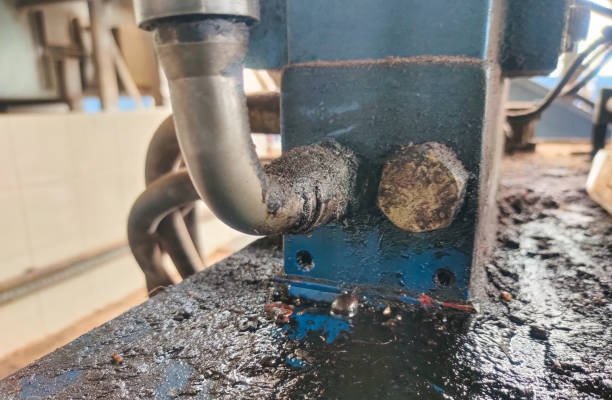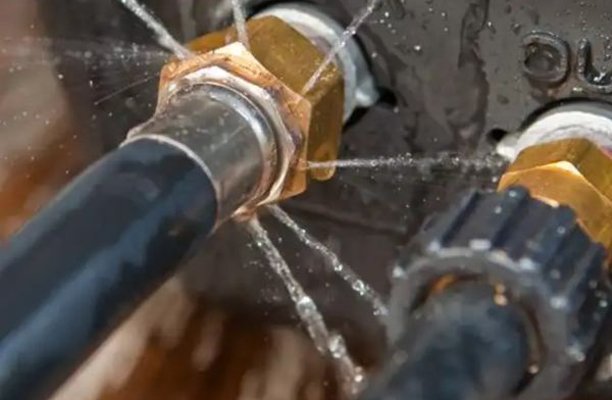Hydraulic systems are essential in a wide range of industries, from manufacturing to automotive, construction, and aerospace. These systems work by using pressurized fluid to transmit power and perform various tasks, such as lifting, pushing, and moving machinery parts. One crucial component that ensures the smooth operation of hydraulic systems is the hydraulic hose fitting. These fittings are designed to create secure, leak-proof connections between hoses and other system components. However, when hydraulic hose fittings begin to leak, they can cause significant disruptions. In this article, we’ll explore the source of the leak, the risks of hydraulic hose fitting leaks, how to identify them, and effective solutions, including repairing hydraulic fitting leaks and selecting the correct hydraulic fitting to prevent future issues.
Introduction to Hydraulic Systems
Hydraulic systems play a pivotal role in industries that require heavy lifting, precise control, and reliable power transmission. In particular, these systems work by using hydraulic hoses and fluid under high pressure to transfer energy. The primary components of a hydraulic system include hydraulic hoses, cylinders, valves, and hydraulic fittings. Specifically, the hydraulic fittings, which connect the hoses to other parts of the system, must maintain a tight, secure seal to ensure proper fluid flow and pressure.
When any of the hydraulic fittings fail, longer downtimes are often inevitable, causing costly delays and potential safety risks. A leaking hydraulic fitting is one of the most common problems in hydraulic systems, and it can be caused by various factors, including improper installation, wear and tear, or environmental influences.
What Are Hydraulic Hose Fittings?
Hydraulic hose fittings are essential components that connect hoses to various parts of a hydraulic system, such as pumps, cylinders, and valves. They are designed to withstand high pressures and create a leak-proof seal that prevents hydraulic fluid from escaping. The most common types of hydraulic fittings include:
Types of Hydraulic Fittings

- Male and Female Fittings: These fittings fit into one another, with one having external threads and the other having internal threads, creating a secure connection.
- JIC (Joint Industry Council) Fittings: Known for their 37-degree flare, JIC fittings create a tight seal and are commonly used in North America.
- BSP (British Standard Pipe) Fittings: These fittings have parallel or tapered threads and are often used in Europe.
- ORFS (O-Ring Face Seal) Fittings: These fittings use an O-ring to form a leak-proof seal and are often used in high-pressure applications.
Choosing the correct hydraulic fitting depends on the application’s pressure and temperature requirements, fluid type, and other environmental factors.
Why Hydraulic Hose Fittings Leak
Understanding the source of the leak is the first step in addressing any hydraulic hose fitting issue. Hydraulic hose fittings are designed to be durable, but over time, they may begin to fail. Here are some of the most common reasons for hydraulic hose fitting leaks:
1. Improper Installation
One of the primary causes of leaks is, in fact, improper installation. Specifically, if the fitting is not correctly aligned or tightened, it can leave small gaps where fluid escapes. Additionally, incorrect torque settings are a frequent contributor to poor fitting installations.
2. Wear and Tear
Hydraulic hose fittings are subjected to extreme pressure, heat, and wear during regular operation. Over time, this can cause the fittings to crack, corrode, or degrade, which can lead to leaks.
3. Contamination
Dirt, debris, or particles introduced into the system during installation or operation can damage the seals or threads on hydraulic hose fittings, causing them to leak.
Incorrect Fitting Selection
Using the wrong size or type of fitting for a particular application can cause the fitting to fail prematurely. For example, using a low-pressure fitting in a high-pressure system can lead to leaks due to inadequate sealing.
Pressure and Temperature Fluctuations
Extreme pressure changes or exposure to hot hydraulic fluid can cause the seals on hydraulic fittings to deteriorate over time, ultimately leading to leaks. As a result, the sealing materials may expand or contract depending on the temperature, and this, in turn, can compromise the fitting’s integrity.
Symptoms of Hydraulic Hose Fittings Leaking
When a hydraulic hose fitting starts leaking, it may not always be immediately obvious. However, certain visual and performance indicators can signal a problem:
Visual Indicators:
- Fluid Pools: Leaks often result in visible pools of hydraulic fluid underneath the fitting. This is especially common in areas with low clearance, making detection difficult.
- Fluid Spray: In high-pressure systems, a leak can result in hot hydraulic fluid spraying out of the fitting, which is a safety hazard.
- Wet Hoses: If the hose near the fitting is wet, it could indicate that the fitting is not properly sealed.
Performance Indicators:
- Pressure Drop: A drop in system pressure is one of the first signs that something is wrong. A leaking fitting can cause a reduction in pressure, affecting the performance of hydraulic cylinders and valves.
- Erratic Machine Operation: Leaking fittings can cause fluctuations in fluid pressure, which in turn can lead to unpredictable machinery behavior.
- Noise: A leaking hydraulic fitting can cause hissing or whistling sounds as fluid escapes under pressure.
The Risks of Hydraulic Hose Fitting Leaks
Leaks in hydraulic hose fittings can lead to numerous problems, not only for equipment performance but also for safety. Below are the primary risks associated with hydraulic hose fitting leaks:
1. Safety Hazards
- Hot Hydraulic Fluid: Leaking hydraulic fluid, especially when it’s hot, can cause severe burns if it comes into contact with personnel.
- Fire Risk: Hydraulic fluid is often flammable, and a leak can create a fire hazard, especially in high-temperature environments.
- Slip and Fall Risks: Leaking hydraulic fluid can create slippery surfaces, leading to accidents and injuries.
2. Environmental Impact
Hydraulic fluid that escapes into the environment can cause contamination, particularly if the fluid is toxic. Leaking hydraulic fittings are a significant contributor to environmental pollution in industrial settings.
3. Equipment Damage
Leaks can cause significant damage to surrounding components, especially if hydraulic fluid corrodes nearby metal parts. Additionally, hydraulic systems are often complex and expensive, and prolonged exposure to leaking fluid can lead to the failure of seals, valves, and pumps.
4. Increased Downtime
Hydraulic hose fittings that leak and are left unaddressed will inevitably lead to longer downtimes. Equipment failure, whether due to damage or a drop in performance, can halt production and cause financial losses.
Diagnosing Hydraulic Hose Fitting Leaks
Properly diagnosing the source of the leak is essential for effective repairs. Here are some methods and tools used for diagnosing hydraulic hose fitting leaks:
1. Visual Inspection
Start by inspecting the hose fittings for any signs of visible damage, such as cracks or worn seals. Leaking fluid may also pool at the base of the fitting, signaling a failure.
2. Pressure Testing
To find the leak’s source, pressure testing involves running the system at a controlled pressure while monitoring for drops in pressure. This can pinpoint exactly where the leak is occurring.
3. Leak Detection Dyes
Adding a leak detection dye to the hydraulic fluid allows for easier detection of leaks. Under ultraviolet light, the dye will illuminate, making the source of the leak easier to identify.
How to Prevent Hydraulic Hose Fitting Leaks
Preventing leaks in hydraulic systems is far less expensive and time-consuming than repairing them. Below are some safety precautions and best practices to prevent hydraulic hose fitting leaks:
1. Proper Installation
Install hydraulic fittings according to the manufacturer’s specifications, using the correct torque settings and ensuring proper alignment. Always double-check the tightness of fittings before pressurizing the system.
2. Routine Inspections
Regularly inspect hydraulic hose fittings and hoses for signs of wear, corrosion, or damage. Catching problems early can prevent leaks from developing.
3. Choosing the Right Materials
Select the correct hydraulic fitting material based on the environment and the type of fluid in use. For example, stainless steel fittings offer greater corrosion resistance for harsh environments.
4. Using Quality Fittings
Always opt for high-quality hydraulic fittings that meet industry standards. Avoid using low-cost alternatives that may fail prematurely under high-pressure or high-temperature conditions.
Repairing Hydraulic Hose Fitting Leaks

If a hydraulic hose fitting is leaking, you can often repair the leak straightforwardly by using the correct tools and following the proper procedures. Here is a step-by-step guide to fixing a hydraulic hose fitting leak:
Step 1: Depressurize the System
Before starting repairs, always depressurize the system to ensure safety. Hydraulic fluid under pressure can be hazardous.
Step 2: Identify the Leak Source
Use methods such as visual inspection, pressure testing, or leak detection dyes to pinpoint the source of the leak.
Step 3: Tighten or Replace the Fitting
If the fitting is loose, tighten it using a torque wrench to the manufacturer’s specifications. If the fitting is cracked or worn, replace it with the correct hydraulic fitting.
Step 4: Test the System
Once repairs are complete, test the system by re-pressurizing and checking for leaks again.
Replacing Hydraulic Hose Fittings
In some cases, repairing the fitting is not an option. If the hydraulic hose fitting is severely damaged, corroded, or worn, replacing it is the best course of action. Always ensure that the replacement fitting is the correct hydraulic fitting for your specific application.
Choosing the Right Hydraulic Hose Fittings
To avoid frequent leaks, always choose the correct hydraulic fitting for the job. Key considerations include:
- Material Compatibility: Ensure the fitting material matches the type of hydraulic fluid used and environmental conditions.
- Pressure Ratings: The fitting should be rated to handle the system’s maximum pressure.
- Size and Thread Compatibility: Match the fitting size and thread type to the hose and system components.
Conclusion:
Hydraulic hose fitting leaks can significantly impact safety and system performance. Identifying the source of the leak quickly and repairing it promptly can save you from costly downtime, environmental damage, and safety hazards. Furthermore, always use the correct hydraulic fitting, follow safety precautions, and conduct regular inspections to ensure your hydraulic system remains leak-free and efficient. By doing so, you can ensure the longevity and reliability of your hydraulic systems.
FAQs
1. What causes hydraulic hose fitting leaks?
Hydraulic hose fitting leaks can happen due to:
- Loose fittings
- Worn or damaged parts
- Incorrect fitting size or type
- Contamination in the system
2. How can I spot a hydraulic hose fitting leak?
You can spot a leak by:
- Looking for wet spots around the fitting or hose
- Listening for hissing sounds
- Noticing a drop in system pressure
- Using a leak detection dye for more precise identification
3. How do I fix a hydraulic hose fitting leak?
To fix a leak:
- Depressurize the system for safety.
- Inspect the fitting for damage or looseness.
- Tighten the fitting or replace it if necessary.
- Test the system again to check for leaks.
4. Should I use sealant on hydraulic hose fittings?
Thread sealant can help prevent leaks, but only use one that’s compatible with your hydraulic fluid and fitting material. It’s important not to rely on sealant alone and to make sure the fitting is properly installed.
5. How can I prevent hydraulic hose fitting leaks?
To prevent leaks:
- Tighten fittings to the correct torque.
- Inspect hoses and fittings regularly for damage.
- Use high-quality parts that are suitable for your system.
- Follow proper installation procedures.
6. When should I replace a hydraulic hose fitting?
Replace the fitting if:
- It’s cracked, corroded, or severely worn.
- Tightening it doesn’t stop the leak.
- It causes repeated issues despite repairs.





